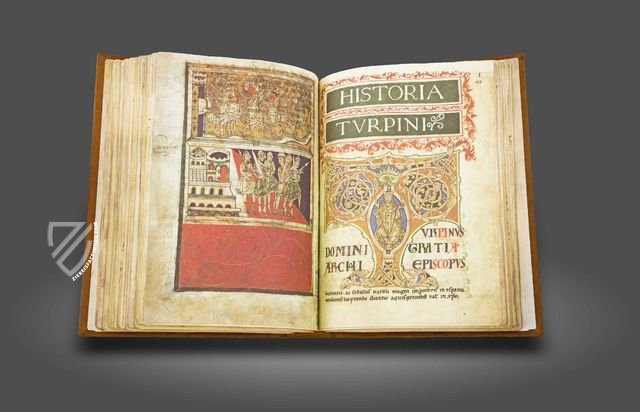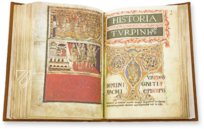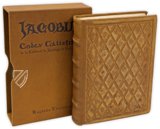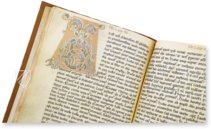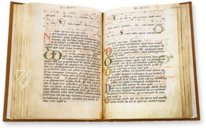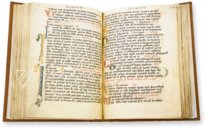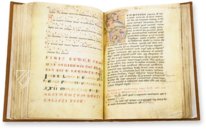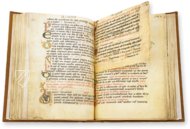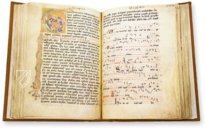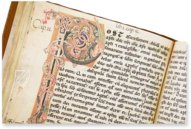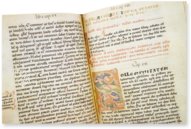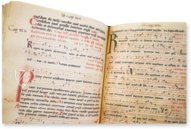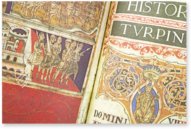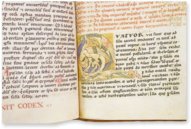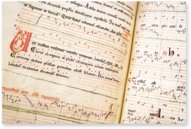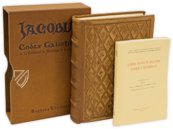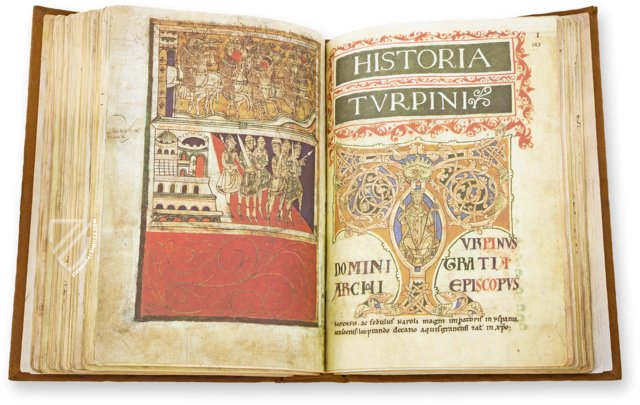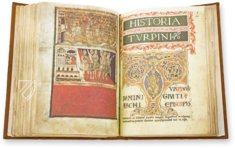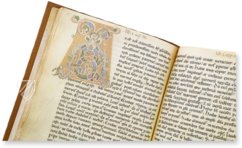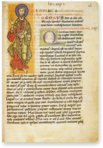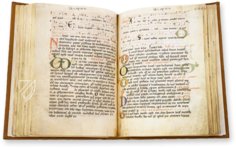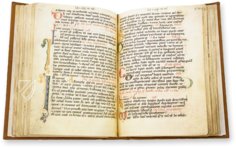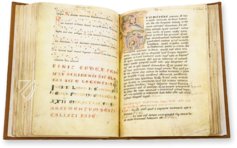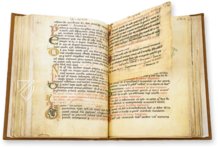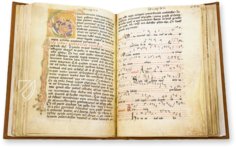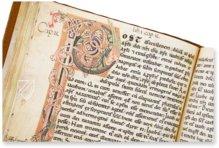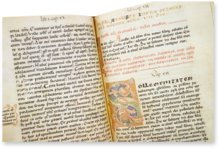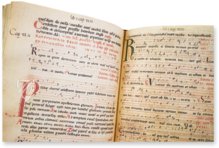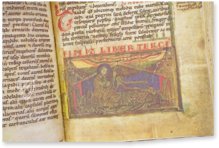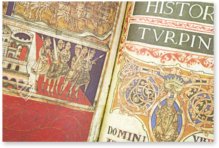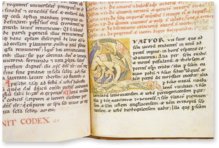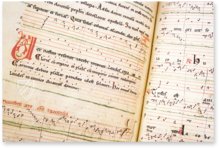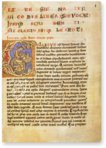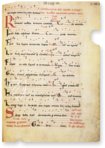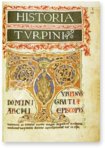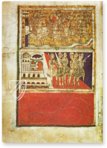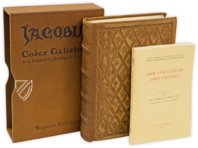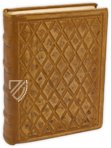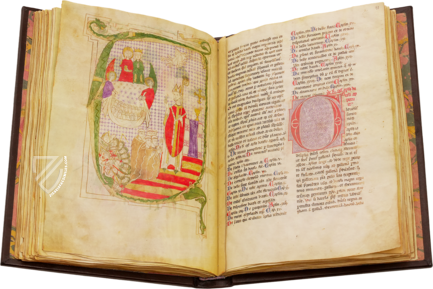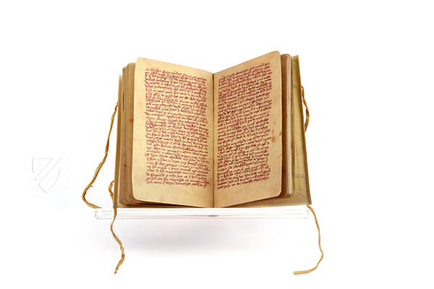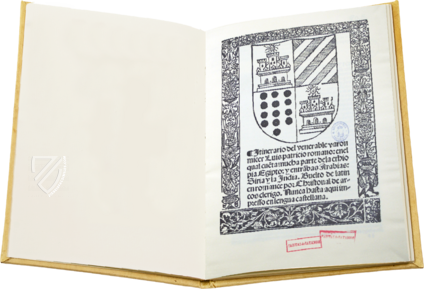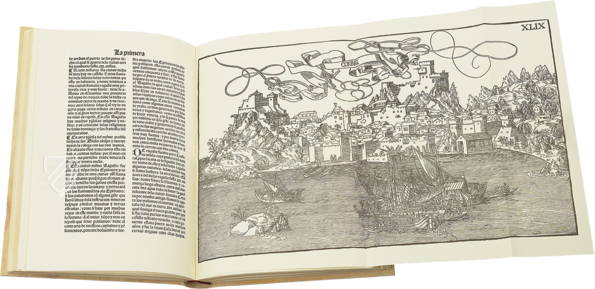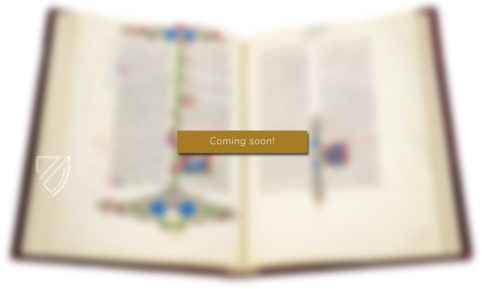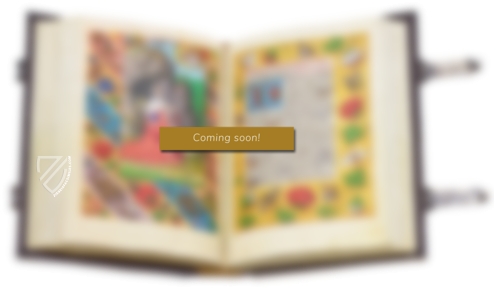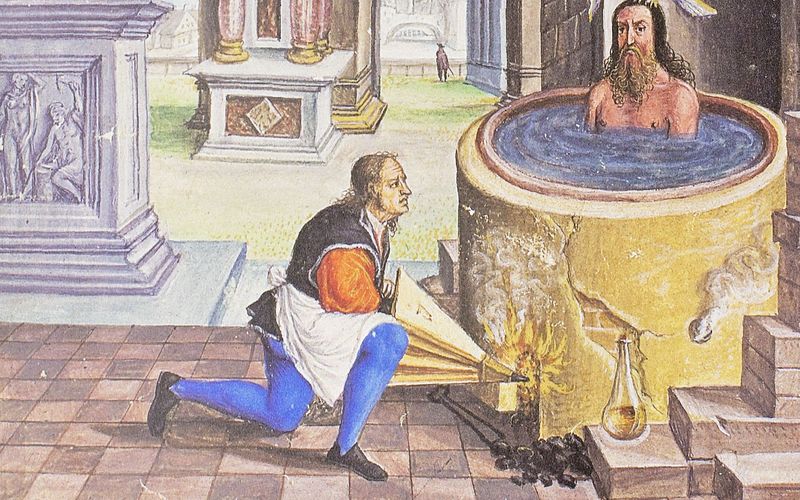Codex Calixtinus of Santiago de Compostela
(3,000€ - 7,000€)
The Codex Calixtinus from the cathedral of Santiago de Compostela is considered to be the “Bible” of the Way of St. James. No other manuscript offers such a wealth of information around the veneration of St. James, from the liturgical texts for holidays to the famous Pseudo-Turpin to the primary section, the detailed pilgrim’s guide. Additionally, the art-historical worth of the famous codex cannot be overestimated: it presents an impressive treasure of Spanish illumination during the Middle Ages!
Codex Calixtinus of Santiago de Compostela
The famous Liber Sancti Iacobi from the library of the cathedral of Santiago de Compostela was considered for a long time to be a work by Pope Calixtus II (1119–1124). As a result, it gained its designation as the Codex Calixtinus, which it retained even after this false attribution was clarified. The Codex Calixtinus is the most important work for the history of the veneration of Saint James. The manuscript presumably originated ca. 1160 as a work from the circles of educated clerics. Thus, for example, the name Aymeric Picaud is closely associated with the manuscript.
The Story of the Way of St. James in Many Aspects
Divided into five books, the “Bible” of the Camino de Santiago encompasses a large wealth of information. After a chapter with liturgical texts and hymns for the celebration of the feasts dedicated to Saint James there is a section with 22 miracle stories associated with the saint. The story of the transfer of the saint’s corpse to Santiago presents further background information on the veneration of the saint. The subsequent text of the so-called Pseudo-Turpin gives an account of Charlemagne and his campaign against the Moors of Spain in the year 778. Finally, the last and most important part of the manuscript contains the famous pilgrimage guide.
A Practical Pilgrim’s Guide
For a long time, this historical pilgrim’s guide from the *Liber Sancti Iacobi made up the foundation for a pilgrimage to Santiago de Compostela. The chapter is further divided into 11 subchapters with detailed itineraries for the various routes with the most important stops at shrines and churches, practical references for the pilgrimage and its course, warnings of dangers, descriptions of the regions through which the pilgrim travelled, and much more fascinating information.
One of the Most Significant Book Treasures of Spain
This diverse text is gorgeously, artfully designed on 450 pages. Exuberant ornamentation, in which insular influences are clearly recognizable, alternate with delightfully figural depictions. The text itself is also extremely tasteful and is elaborately designed and adorned with lavish initials. With such splendor, the Codex Calixtinus is a true treasure of 12th century Spanish illumination, which stands ready with a new surprise for the reader on every page!
Codicology
- Alternative Titles
- Codex Calixtinus of Santiago de Compostela
Codex Calixtinus de la Catedral de Santiago de Compostela
Liber Sancti Jacobi
Book of Saint James
Compostellus - Size / Format
- 450 pages / 29.5 × 21.2 cm
- Origin
- Spain
- Date
- 1138–1173
- Epochs
- Style
- Script
- Protogothic minuscule
- Illustrations
- 3 large miniatures; 3 large historiated initials; 18 floral and zoomorphic decorated initials; countless smaller initials
- Content
- 5 books: Liturgical texts and polyphonic chants for the feast days of St. James; 22 miracle stories of St. James; Narration of the translation of the body of St. James to Santiago; Pseudo-Turpin's tale of Charlemagne and Roland; pilgrim's guide.
Also: le - Previous Owners
- José Manuel Fernández Castiñeira
Codex Calixtinus of Santiago de Compostela
Charlemagne on the Route to Campostela
This codex is appended by a subsequent text, the so-called Pseudo-Turpin, which is so-named because it was falsely attributed to Archbishop Turpin of Reims. It is a quasi-historical narrative of Charlemagne’s Spanish campaign that tells of how St. James appeared to the Frankish King in a dream, urging Charlemagne to liberate his tomb from the Moors and directing him to follow the route of the Milky Way. Charlemagne, Roland, and other knights are shown here departing on this divine mission.
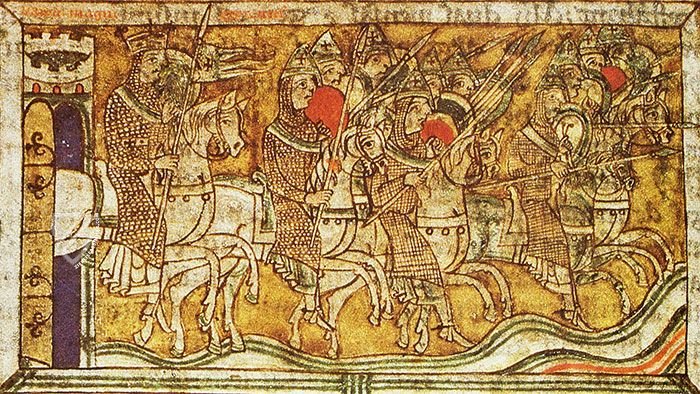
Codex Calixtinus of Santiago de Compostela
Portrait of St. James
The man at the center of the famous pilgrimage to Santiago de Compostela Cathedral in northwestern Spain was Saint James, one of the Twelve Apostles who was also the brother of John the Apostle. Known as the “Way of St. James”, this pilgrimage root has been popular since the Early Middle Ages and continues to draws hundreds of thousands of people every year.
Saint James is shown giving the sign of benediction and holding a codex to the left of the incipit at the beginning of the main text. It is a fine miniature blending the Romanesque style with the native Iberian style characteristic of Beatus manuscripts. Introduced by a large “Q” initial, the text is neatly written in a miniscule script by an experienced hand.
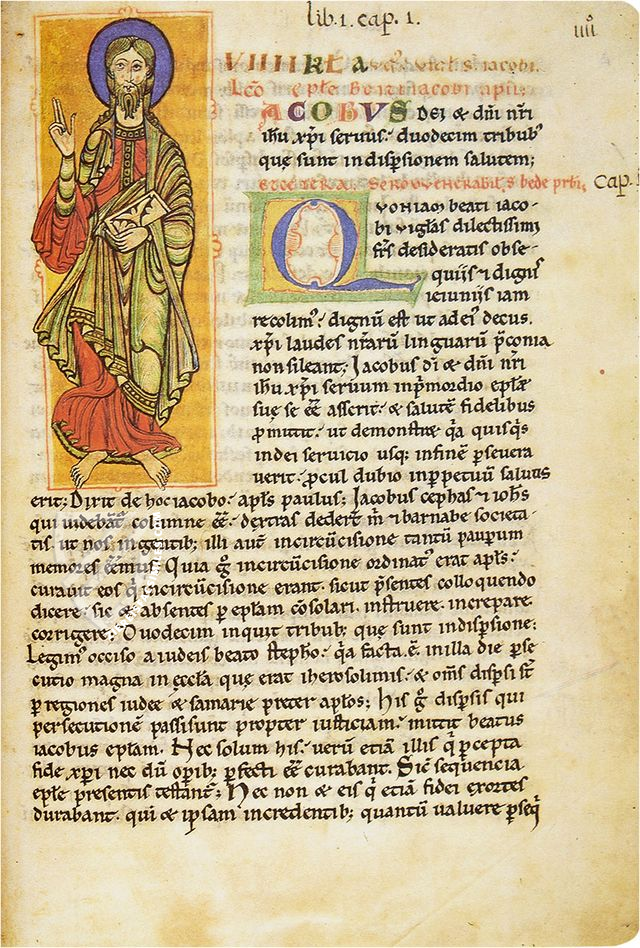
#1 Codex Calixtinus de la Catedral de Santiago de Compostela
(3,000€ - 7,000€)
- Treatises / Secular Books
- Apocalypses / Beatus
- Astronomy / Astrology
- Bestiaries
- Bibles / Gospels
- Chronicles / History / Law
- Geography / Maps
- Saints' Lives
- Islam / Oriental
- Judaism / Hebrew
- Single Leaf Collections
- Leonardo da Vinci
- Literature / Poetry
- Liturgical Manuscripts
- Medicine / Botany / Alchemy
- Music
- Mythology / Prophecies
- Psalters
- Other Religious Books
- Games / Hunting
- Private Devotion Books
- Other Genres
- Afghanistan
- Armenia
- Austria
- Belgium
- Belize
- Bosnia and Herzegovina
- China
- Colombia
- Costa Rica
- Croatia
- Cyprus
- Czech Republic
- Denmark
- Egypt
- El Salvador
- Ethiopia
- France
- Germany
- Greece
- Guatemala
- Honduras
- Hungary
- India
- Iran
- Iraq
- Israel
- Italy
- Japan
- Jordan
- Kazakhstan
- Kyrgyzstan
- Lebanon
- Liechtenstein
- Luxembourg
- Mexico
- Morocco
- Netherlands
- Palestine
- Panama
- Peru
- Poland
- Portugal
- Romania
- Russia
- Serbia
- Spain
- Sri Lanka
- Sweden
- Switzerland
- Syria
- Tajikistan
- Turkey
- Turkmenistan
- Ukraine
- United Kingdom
- United States
- Uzbekistan
- Vatican City
- A. Oosthoek, van Holkema & Warendorf
- Aboca Museum
- Ajuntament de Valencia
- Akademie Verlag
- Akademische Druck- u. Verlagsanstalt (ADEVA)
- Aldo Ausilio Editore - Bottega d’Erasmo
- Alecto Historical Editions
- Alkuin Verlag
- Almqvist & Wiksell
- Amilcare Pizzi
- Andreas & Andreas Verlagsbuchhandlung
- Archa 90
- Archiv Verlag
- Archivi Edizioni
- Arnold Verlag
- ARS
- Ars Magna
- ArtCodex
- AyN Ediciones
- Azimuth Editions
- Badenia Verlag
- Bärenreiter-Verlag
- Belser Verlag
- Belser Verlag / WK Wertkontor
- Benziger Verlag
- Bernardinum Wydawnictwo
- BiblioGemma
- Biblioteca Apostolica Vaticana (Vaticanstadt, Vaticanstadt)
- Bibliotheca Palatina Faksimile Verlag
- Bibliotheca Rara
- Boydell & Brewer
- Bramante Edizioni
- Bredius Genootschap
- Brepols Publishers
- British Library
- C. Weckesser
- Caixa Catalunya
- Canesi
- CAPSA, Ars Scriptoria
- Caratzas Brothers, Publishers
- Carus Verlag
- Casamassima Libri
- Centrum Cartographie Verlag GmbH
- Chavane Verlag
- Christian Brandstätter Verlag
- Circulo Cientifico
- Club Bibliófilo Versol
- Club du Livre
- CM Editores
- Collegium Graphicum
- Collezione Apocrifa Da Vinci
- Comissão Nacional para as Comemorações dos Descobrimentos Portugueses
- Coron Verlag
- Corvina
- CTHS
- D. S. Brewer
- Damon
- De Agostini/UTET
- De Nederlandsche Boekhandel
- De Schutter
- Deuschle & Stemmle
- Deutscher Verlag für Kunstwissenschaft
- DIAMM
- Droz
- E. Schreiber Graphische Kunstanstalten
- Ediciones Boreal
- Ediciones Grial
- Ediclube
- Edições Inapa
- Edilan
- Editalia
- Edition Deuschle
- Edition Georg Popp
- Edition Leipzig
- Edition Libri Illustri
- Editiones Reales Sitios S. L.
- Éditions de l'Oiseau Lyre
- Editions Medicina Rara
- Editorial Casariego
- Editorial Mintzoa
- Editrice Antenore
- Editrice Velar
- Edizioni Edison
- Egeria, S.L.
- Eikon Editores
- Electa
- Emery Walker Limited
- Enciclopèdia Catalana
- Eos-Verlag
- Ephesus Publishing
- Ernst Battenberg
- Eugrammia Press
- Extraordinary Editions
- Fackelverlag
- Facsimila Art & Edition
- Facsimile Editions Ltd.
- Facsimilia Art & Edition Ebert KG
- Faksimile Verlag
- Feuermann Verlag
- Folger Shakespeare Library
- Franco Cosimo Panini Editore
- Friedrich Wittig Verlag
- Fundación Hullera Vasco-Leonesa
- G. Braziller
- Gabriele Mazzotta Editore
- Gebr. Mann Verlag
- Gesellschaft für graphische Industrie
- Getty Research Institute
- Giovanni Domenico de Rossi
- Giunti Editore
- Graffiti
- Grafica European Center of Fine Arts
- Guido Pressler
- Guillermo Blazquez
- Gustav Kiepenheuer
- H. N. Abrams
- Harrassowitz
- Harvard University Press
- Helikon
- Hendrickson Publishers
- Henning Oppermann
- Herder Verlag
- Hes & De Graaf Publishers
- Hoepli
- Holbein-Verlag
- Houghton Library
- Hugo Schmidt Verlag
- Idion Verlag
- Il Bulino, edizioni d'arte
- ILte
- Imago
- Insel Verlag
- Insel-Verlag Anton Kippenberger
- Instituto de Estudios Altoaragoneses
- Instituto Nacional de Antropología e Historia
- Introligatornia Budnik Jerzy
- Istituto dell'Enciclopedia Italiana - Treccani
- Istituto Ellenico di Studi Bizantini e Postbizantini
- Istituto Geografico De Agostini
- Istituto Poligrafico e Zecca dello Stato
- Italarte Art Establishments
- Jan Thorbecke Verlag
- Johnson Reprint Corporation
- Josef Stocker
- Josef Stocker-Schmid
- Jugoslavija
- Karl W. Hiersemann
- Kasper Straube
- Kaydeda Ediciones
- Kindler Verlag / Coron Verlag
- Kodansha International Ltd.
- Konrad Kölbl Verlag
- Kurt Wolff Verlag
- La Liberia dello Stato
- La Linea Editrice
- La Meta Editore
- Lambert Schneider
- Landeskreditbank Baden-Württemberg
- Leo S. Olschki
- Les Incunables
- Liber Artis
- Library of Congress
- Libreria Musicale Italiana
- Lichtdruck
- Lito Immagine Editore
- Lumen Artis
- Lund Humphries
- M. Moleiro Editor
- Maison des Sciences de l'homme et de la société de Poitiers
- Manuscriptum
- Martinus Nijhoff
- Maruzen-Yushodo Co. Ltd.
- MASA
- Massada Publishers
- McGraw-Hill
- Metropolitan Museum of Art
- Militos
- Millennium Liber
- Müller & Schindler
- Nahar - Stavit
- Nahar and Steimatzky
- National Library of Wales
- Neri Pozza
- Nova Charta
- Oceanum Verlag
- Odeon
- Orbis Mediaevalis
- Orbis Pictus
- Österreichische Staatsdruckerei
- Oxford University Press
- Pageant Books
- Parzellers Buchverlag
- Patrimonio Ediciones
- Pattloch Verlag
- PIAF
- Pieper Verlag
- Plon-Nourrit et cie
- Poligrafiche Bolis
- Presses Universitaires de Strasbourg
- Prestel Verlag
- Princeton University Press
- Prisma Verlag
- Priuli & Verlucca, editori
- Pro Sport Verlag
- Propyläen Verlag
- Pytheas Books
- Quaternio Verlag Luzern
- Reales Sitios
- Recht-Verlag
- Reichert Verlag
- Reichsdruckerei
- Reprint Verlag
- Riehn & Reusch
- Roberto Vattori Editore
- Rosenkilde and Bagger
- Roxburghe Club
- Salerno Editrice
- Saltellus Press
- Sandoz
- Sarajevo Svjetlost
- Schöck ArtPrint Kft.
- Schulsinger Brothers
- Scolar Press
- Scrinium
- Scripta Maneant
- Scriptorium
- Shazar
- Siloé, arte y bibliofilia
- SISMEL - Edizioni del Galluzzo
- Sociedad Mexicana de Antropología
- Société des Bibliophiles & Iconophiles de Belgique
- Soncin Publishing
- Sorli Ediciones
- Stainer and Bell
- Studer
- Styria Verlag
- Sumptibus Pragopress
- Szegedi Tudomànyegyetem
- Taberna Libraria
- Tarshish Books
- Taschen
- Tempus Libri
- Testimonio Compañía Editorial
- Thames and Hudson
- The Clear Vue Publishing Partnership Limited
- The Facsimile Codex
- The Folio Society
- The Marquess of Normanby
- The Richard III and Yorkist History Trust
- Tip.Le.Co
- TouchArt
- TREC Publishing House
- TRI Publishing Co.
- Trident Editore
- Tuliba Collection
- Typis Regiae Officinae Polygraphicae
- Union Verlag Berlin
- Universidad de Granada
- University of California Press
- University of Chicago Press
- Urs Graf
- Vallecchi
- Van Wijnen
- VCH, Acta Humaniora
- VDI Verlag
- VEB Deutscher Verlag für Musik
- Verlag Anton Pustet / Andreas Verlag
- Verlag Bibliophile Drucke Josef Stocker
- Verlag der Münchner Drucke
- Verlag für Regionalgeschichte
- Verlag Styria
- Vicent Garcia Editores
- W. Turnowski Ltd.
- W. Turnowsky
- Waanders Printers
- Wiener Mechitharisten-Congregation (Wien, Österreich)
- Wissenschaftliche Buchgesellschaft
- Wissenschaftliche Verlagsgesellschaft
- Wydawnictwo Dolnoslaskie
- Xuntanza Editorial
- Zakład Narodowy
- Zollikofer AG

